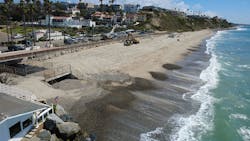OCTA advances Coastal Rail Resiliency Study to safeguard San Clemente rail line
The Orange County Transportation Authority (OCTA) is advancing its Coastal Rail Resiliency Study to safeguard the Los Angeles–San Diego–San Luis Obispo (LOSSAN) Rail Corridor along the south Orange County coast.
The study aims to identify and evaluate strategies that would protect the seven-mile coastal rail segment between Dana Point and the San Diego County line from erosion, bluff instability and the effects of ocean waves nearing the rail line. OCTA notes the study builds on its ongoing work to ensure the safety and reliability of passenger and freight rail service while protecting coastal access and the environment. The study is part of a broader, multi-agency effort to address both immediate and long-term challenges to the rail corridor.
“After years of reacting to sea encroaching and bluff destabilization along our rail corridor, we begin studying viable, proactive solutions for the future,” said OCTA Director and Orange County Fifth District Supervisor Katrina Foley. “While the state undertakes the long-term study to potentially relocate the LOSSAN Rail Corridor, OCTA continues advancing our mid-term stabilization efforts. By investing in sand renourishment to save Orange County’s eroding beaches, OCTA protects our ocean economy and national security while ensuring rail stability for local commuters for decades to come.”
The study is part of OCTA’s proactive approach to enhancing resiliency of the LOSSAN Rail Corridor, which serves nearly eight million passengers annually and is a vital freight route supporting Southern California’s economy. The study complements ongoing emergency stabilization work in San Clemente and advances short-term to mid-term efforts that will protect rail service, coastal access and the local environment for up to the next 30 years.
OCTA notes a separate state-led study will look at solutions beyond 30 years, potentially including relocating the rail line inland.
